Ahead of this game of the 13th matchday of the Bundesliga Bayern Munich had 24 points and won the first two Bundesliga games under their new interim manager Hans-Dieter Flick against Dortmund and Fortuna Düsseldorf. They sat in the third position while Bayer Leverkusen were ninth with 19 points. However, while this game promised to be interesting since Leverkusen are usually a team that like to dominate the game, this wouldn’t be the case in this clash. Leverkusen’s approach, therefore, would be interesting to watch.
In this tactical analysis, we’ll investigate both team’s tactics and discuss how Leverkusen were able to win away from home against the current German champions Bayern 2-1.
Lineups
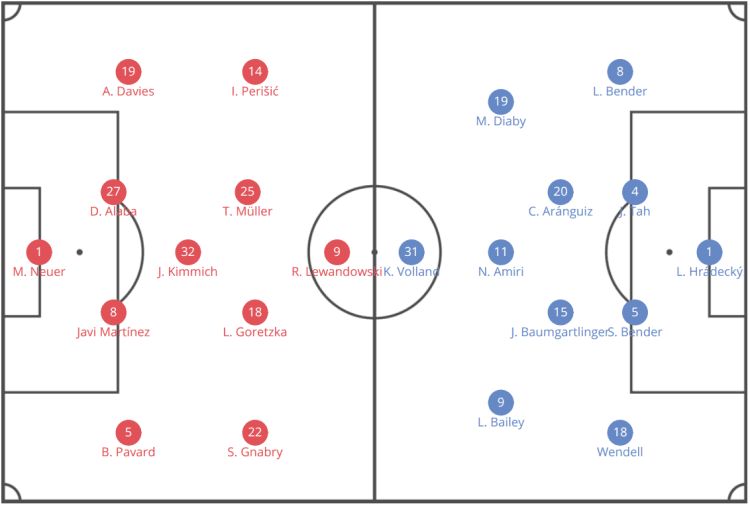
Flick lined his team up in their typical 4-1-4-1 formation with Manuel Neuer in goal and a back four in front of him which consisted of Alphonso Davies, David Alaba, Javier Martínez, and Benjamin Pavard. Joshua Kimmich was the only defensive midfielder while Leon Goretzka and Thomas Müller were also part of the central midfield. Serge Gnabry and Ivan Perišić provided the width while Robert Lewandowski was, as usual, the single striker.
On the other side, Peter Bosz used a 4-2-3-1 formation with Lukáš Hrádecký between the sticks while the back four was made of Wendell, Sven Bender, Jonathan Tah, and Lars Bender. Julian Baumgartlinger and Charles Aránguiz were the defensive midfielders. Nadiem Amiri was in front of them and the wings were occupied by Leon Bailey and Moussa Diaby. Kevin Volland was the lone man up front.
No time to play for both teams
Right from the beginning, both teams tried to put pressure on their opponents extremely high up the pitch. Both teams used a high pressing to not give the opposition any time to have a calm and structured build-up. Due to that, the opening minutes of the game were very hectic and neither Bayern nor Leverkusen were able to control the game. Besides, both teams utilised their typical counter-pressing which just made it even harder for both teams to have pass combinations.
The Bavarians used mostly a man-orientated approach to give the Werkself no time to breathe. Bosz’s team is among the teams in the Bundesliga who want to dominate the game with possession as already mentioned in this analysis. Leverkusen are behind Bayern as the team in the Bundesliga which have on average the highest value for possession per 90 minutes. Considering this, Flick’s men knew that they would have to press in early at their opponents to deny them the chance to have a structured build-up as can be seen in the image below.
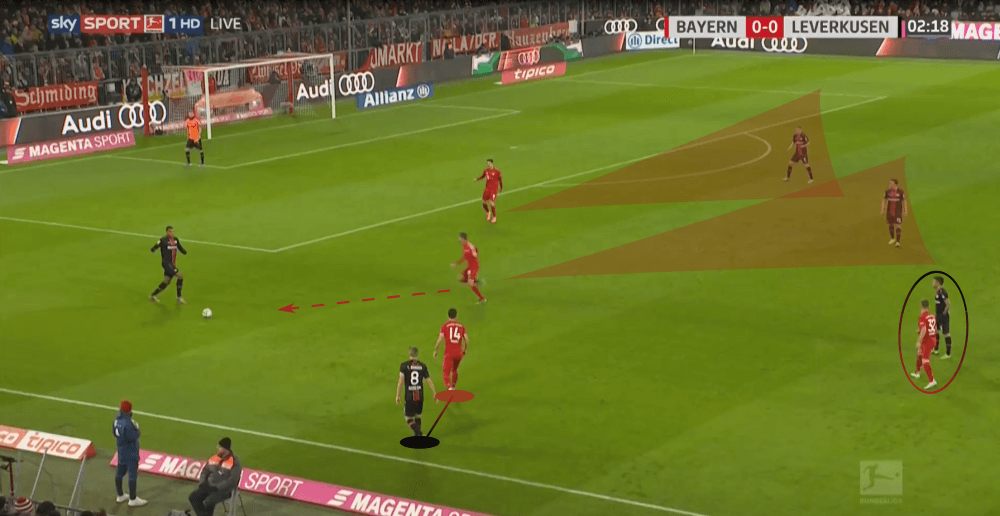
However, Leverkusen had the exact same plan for the opening minutes. They also didn’t want to give the Bavarians the time and space to build up their attacks from their back. However, another aspect could be seen which didn’t change throughout the game: Amiri man-marked Kimmich when Bayern were in possession. Since the German international is one of the best players in Europe when it comes to organising the build-up, this makes sense. Even though Leverkusen sat back deeper later in the game, this aspect of their tactics never changed.
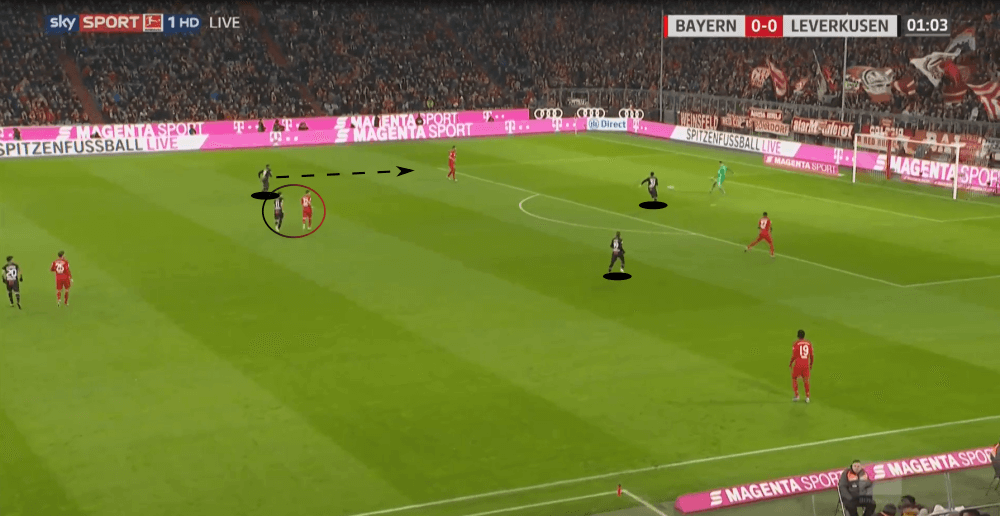
When you use such a high press as these two teams did in the opening phase of this game, it’s logical that the opposition would have a lot of space as soon as they can overcome this press. Leverkusen were, in this period of the game, almost never able to play past Bayern’s press while Flick’s team were and they had a lot of space in these situations as shown below.
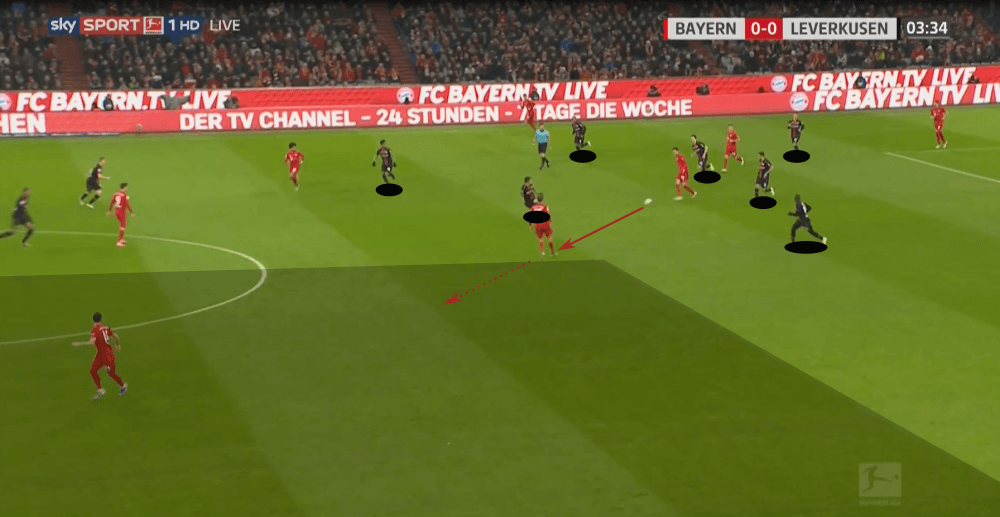
During the first minutes of the match, no team had control over the game, but the Bavarians were able to create some goalscoring chances as they were able to overcome Leverkusen’s press in some situations. However, after the first 10 to 15 minutes, Bosz’s team sat back deeper which is logical since from a physical point of view, it was impossible to play such an intense style of play over the full time.
Bosz’s defensive plan and Volland as the target in transitional moments
Leverkusen’s defensive shape switched between a 4-4-2 and a 4-4-1-1 as it depended on Amiri’s position. The young German midfielder tracked Kimmich and because of that, he had no clear position when the opposition were in possession. This meant Volland was the lone man up front who put pressure on Martínez and Alaba while Aránguiz and Baumgartlinger had the task of occupying the centre. It’s also worth mentioning that they did well in varying different heights when they started the press. In some situations, they sat back deeper and Volland put pressure on Bayern’s centre-backs a few yards in Leverkusen’s half, and just a few moments later the whole team pushed forward to press in higher up the field.
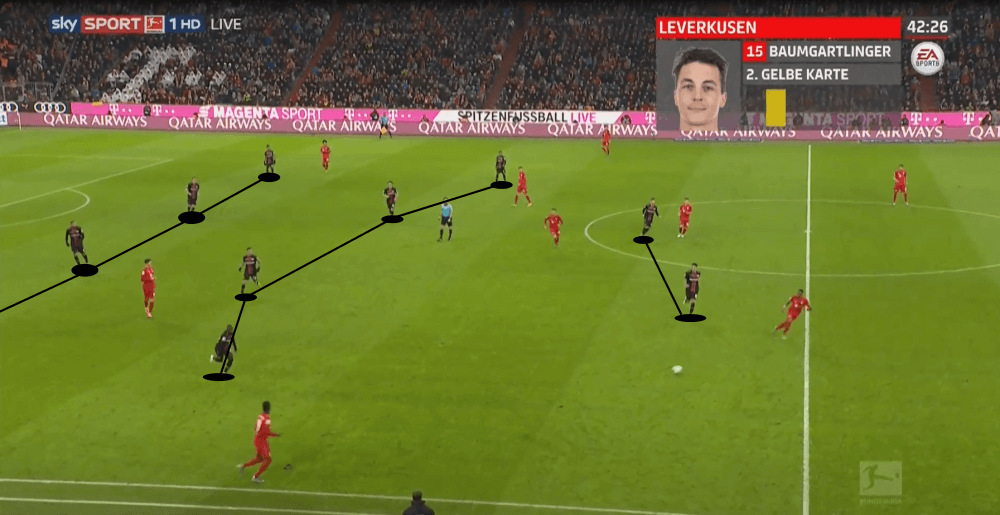
However, Amiri always followed Kimmich to either avoid passes to him, or when his opponent was on the ball, to then give him no time to play a controlled pass. This was especially the case in the second half when Amiri and Volland shared this task as one man-marked Kimmich and the other one put pressure on the defenders and shifted from one side to the other. In the first half it was mainly Amiri who followed Kimmich as we see below.
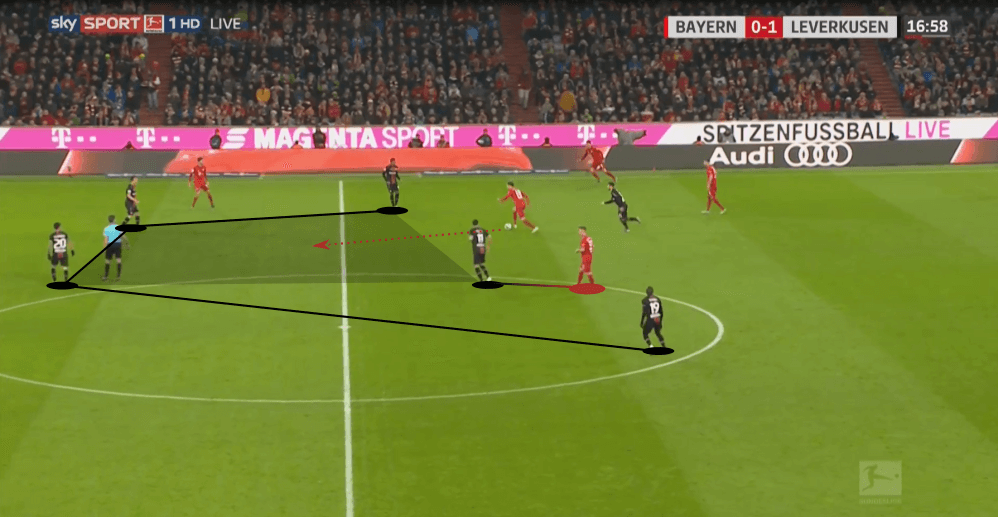
The consequence of this tactic was that Kimmich often dropped deeper between the two centre-backs to create a kind of a back three. In these situations, he wanted to create distance between him and Amiri to have more time on the ball and organise the build-up. However, this movement meant that Amiri could focus on cutting off passing lanes with his cover shadow while Bayern had even one player less in the higher positions. Due to that, this deeper position of Kimmich didn’t really help Bayern, but we’ll come back to this aspect later in this analysis.
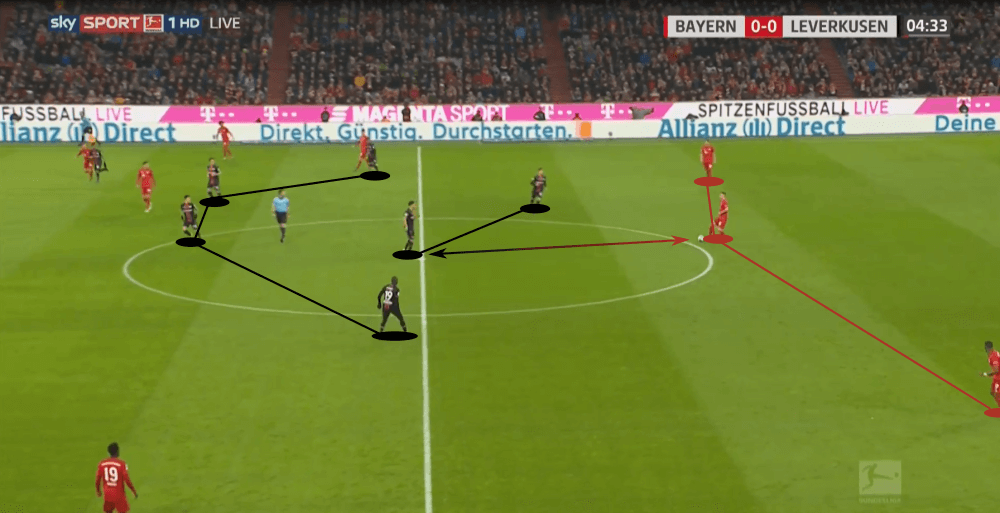
However, Leverkusen also had a plan for how they wanted to get dangerous upfront and even come in areas from where they could score goals as such. Since Bayern mostly executed a high press and additionally dominated the game with possession, Bosz’s plan was to hit Bayern on the break. Leverkusen had in the whole game 11 counterattacks compared to Bayern’s two. They wanted to get dangerous with counter-attacks and had a certain idea of how they wanted to progress the ball in such situations.
Their pattern was to find Volland in the centre up front who would then play through passes to Bailey or Diaby. Both wingers have incredible acceleration and high speed which they wanted to utilise in these moments of transition, and in the first half this plan worked off several times since in two situations they resulted in a goal.
Ahead of the first goal, the young left-back Davies lost the ball on the wing. Seconds later, Amiri passed the ball to the single striker Volland. Notice in the first shot below that he positions himself a bit deeper to create a kind of a triangle with the centre-backs of Bayern. This distance gives him the time and space to control the ball and Martínez has to come out of the line of the back four. This creates space for the left-winger Bailey who starts a sprint to go into the gap between Martínez and right-back Pavard. There were also two other factors. Firstly, Bailey is, in general, faster than the French right-back and additionally, due to his deeper position, he had the chance to pick up speed while Pavard was standing and because of that he already had a high speed while his opponent started to run. Secondly, Pavard would have to position himself more centrally as soon as he sees that his teammate Martínez has to step out of the last line. Then Volland would have to play the pass to the outside and not through the centre. However, the French right-back didn’t realise it fast enough and just moments later Bailey already picked up so much speed that Pavard couldn’t follow him and the Jamaican scored the first goal in the 10th minute.
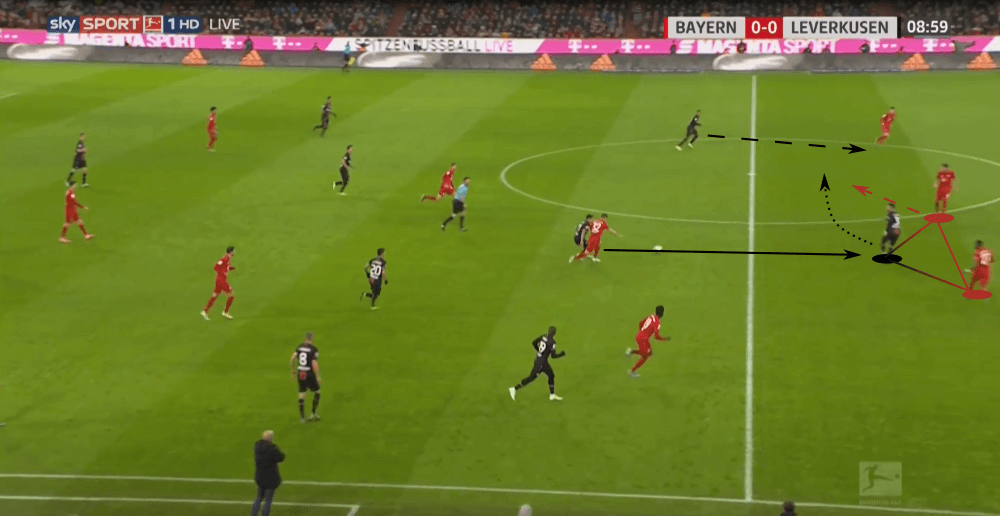
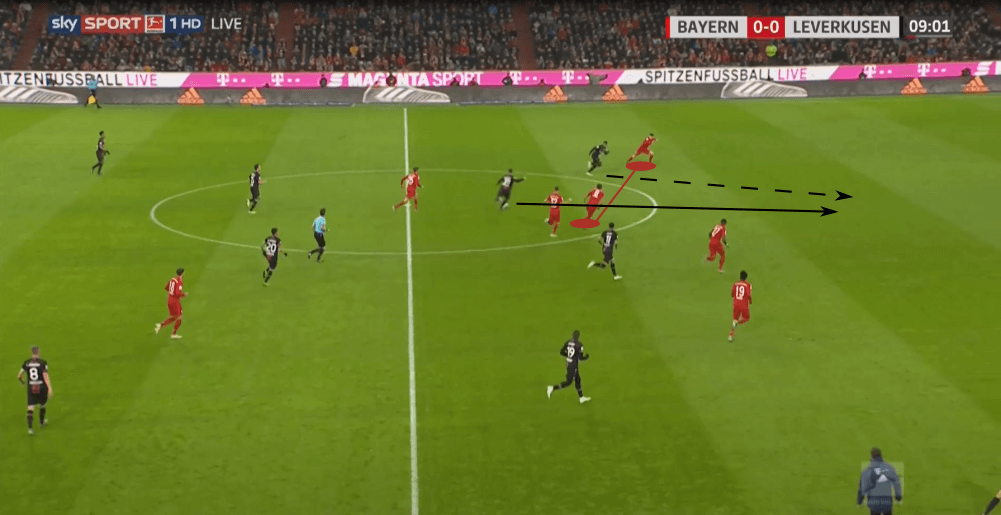
Ahead of the 2-1 which happened just 113 seconds after Bayern’s equaliser, Leverkusen once more used the same pattern to bring Bailey in a dangerous situation. Aránguiz cleared a situation with a long ball which landed at Bailey. The Jamaican laid off the ball for Volland who needed one touch to control the ball, and then once more played a perfect through pass back to Bailey. This time, the left-winger was in a sprint duel against Martínez as Pavard was still up front as he supported his teammates during the attack which resulted in this counter-attack. Bailey scored his second goal of the night while both were assisted by Volland.
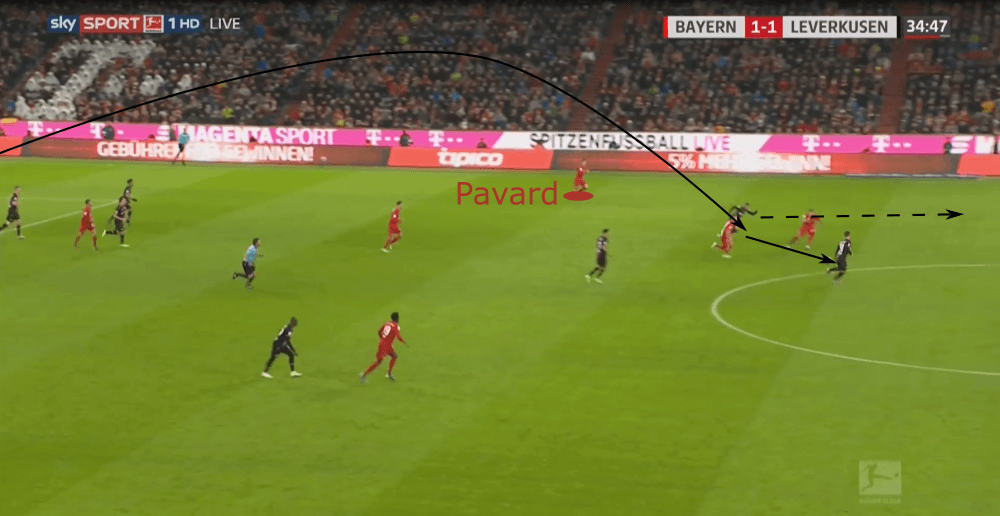
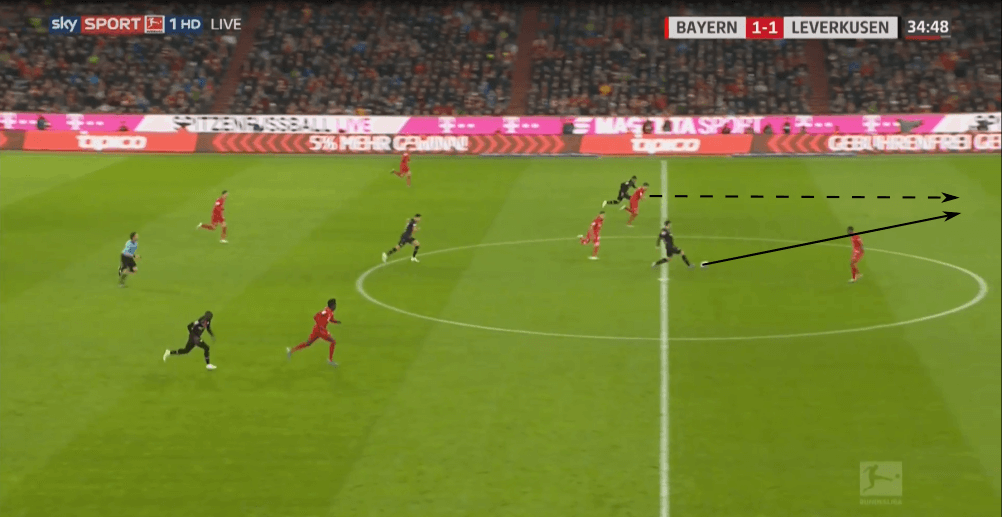
Bayern’s variability
Even though Leverkusen defended with passion and discipline, Bayern created way more goalscoring opportunities throughout the game and it would be no surprise if they had scored more goals considering how many chances they created. Their xG value after the match was 2.66 while Leverkusen’s was 1.06. The interesting thing is, ahead of this game one of the central topics in the media was how the conversion of chances by Leverkusen would cost them many points within the last weeks. While in this game they had again missed some opportunities, all in all, they were way more efficient compared to the Bavarians.
On some occasions, we saw why Bosz wanted Amiri to take Kimmich out of the game as much as possible. Whenever the German got on the ball in a higher line without being marked by Amiri, he instantly was able to create a dangerous situation with a pass. Since Amiri did his job well, this situation occurred just a few times during the whole match, and mainly after a successful counter-pressing by Bayern since in these moments, Amiri was somewhere else as Leverkusen just won the ball moments ahead. The image below shows such an example after a successful counter-press of Bayern and Kimmich was for one second unmarked. He played a perfect through pass to Gnabry who laid the ball off for Müller. However, the left-back Wendell cleared the situation just before Müller would have the chance to tap the ball in the empty goal.
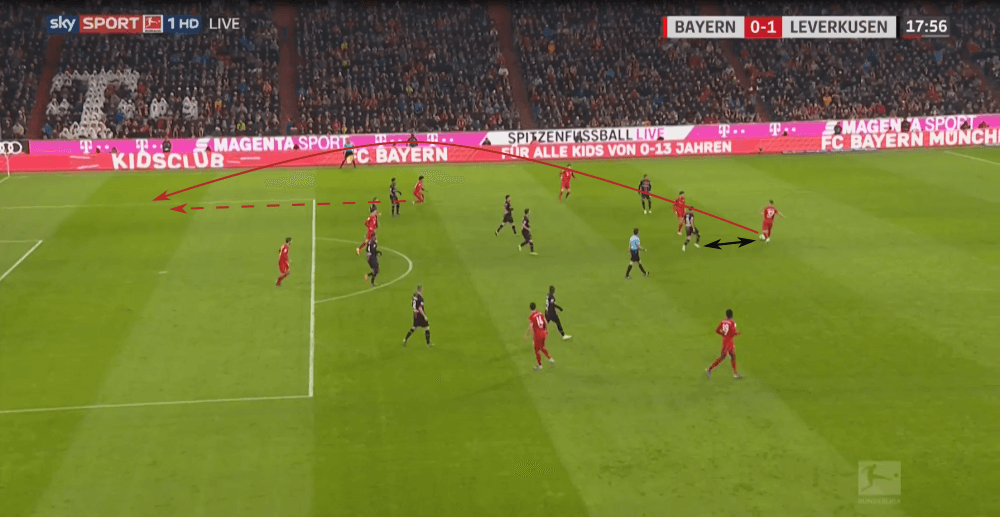
The Bavarians rotated in the higher lines a lot to permanently create new passing options. Lewandowski moved on both wings, the wingers tucked in to create space for the full-backs who then pushed forward and additionally, Müller and Goretzka moved all over the pitch. Goretzka sometimes also positioned deeper to fill up the space in front of the back three when Kimmich dropped between the centre-backs while Müller typically could be found all over the place. Due to the various movements, we also saw different patterns and ways of how Bayern created goalscoring chances.
Since Kimmich was marked, Alaba and Martínez were most of the time responsible for the build-up. Alaba especially often tried to find Lewandowski, Goretzka, or Perišić in the left half-space. When the Croatian winger shifted inside to occupy the half-space, the left-back Davies used his incredible pace to start a deep run behind Leverkusen’s defence. Since he’s faster than the right-back of the Werkself, Lars Bender, they tried to find him with such through passes to exploit his speed. In the example below, Perišić moved inside where Alaba found him with a penetrating vertical pass. He immediately turned around to then play a through pass to Davies. The Canadian international delivered a low cross which Gnabry hit over the crossbar. However, we saw this pattern on the left side more frequently than on the right one since Davies was clearly faster than Lars Bender while on the other side Pavard would lose such a duel against the Brazilian left-back Wendell due to his lack of speed.
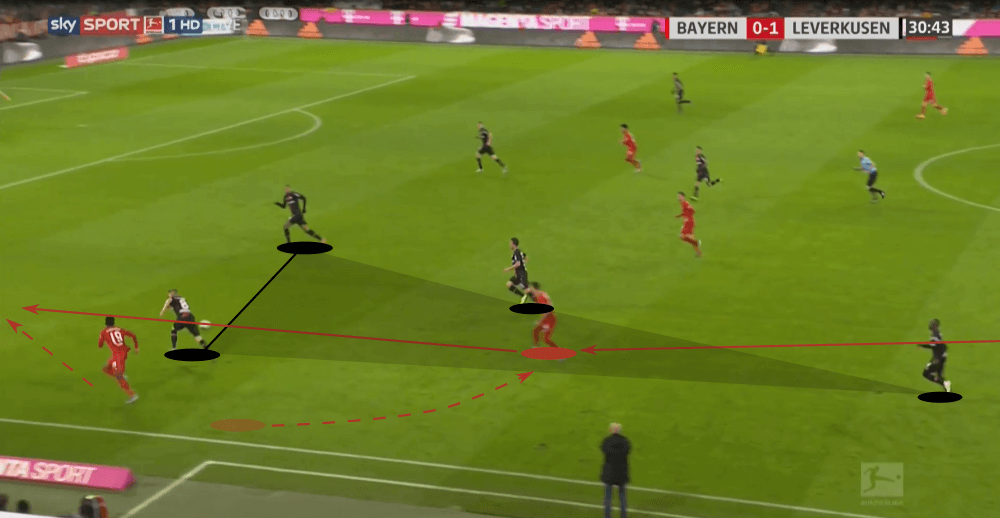
However, the following example once more proves how variable Bayern played. Just one minute ahead of the first goal of the day which was scored by Bailey, the Bundesliga Player of the Month of October Gnabry missed a huge chance. The right-winger suddenly appeared in the left half-space. The left-back Lars Bender was pinned to the wide area as Perišić was positioned on the wing. Amiri was man-marking Kimmich while Volland was too far away from Alaba. The Austrian had the time to detect Gnabry’s movement who came one step towards Alaba which forced the centre-back Tah to follow him. However, Gnabry turned around to receive a perfectly timed through pass from his Austrian teammate. The German winger was too fast for his opponent, but he failed to convert the one-on-one situation against the goalkeeper into a goal and just hit the post (the first of Bayern’s four times in this match).
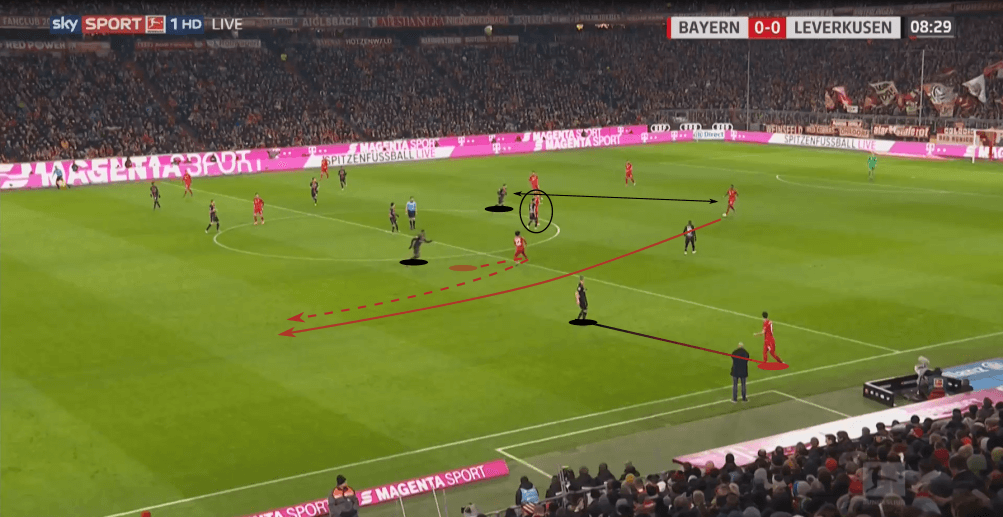
In light of this, Bayern used high through passes behind the last line of Leverkusen as the example of Kimmich showed, they tried to use positional rotations and also through passes to Gnabry and Davies to get in front of the goal. However, at the end of the day, their only goal of this match resulted out of a high pressing. They cut off all short passing options for the centre-back Sven Bender. Only left-back Wendell was free, but Gnabry used a curved run to also cut off the passing lane to the Brazilian with the aid of his cover shadow. Sven Bender decided to play a long ball but instead of blasting it away, he played a controlled pass, intending to find Bailey or Volland. However, Bayern’s defenders intercepted the ball and caught Leverkusen in a moment in which they weren’t organised which gave Müller the space and time to score the equaliser. However, as already mentioned just 113 seconds later Bailey scored to make it 1-2.
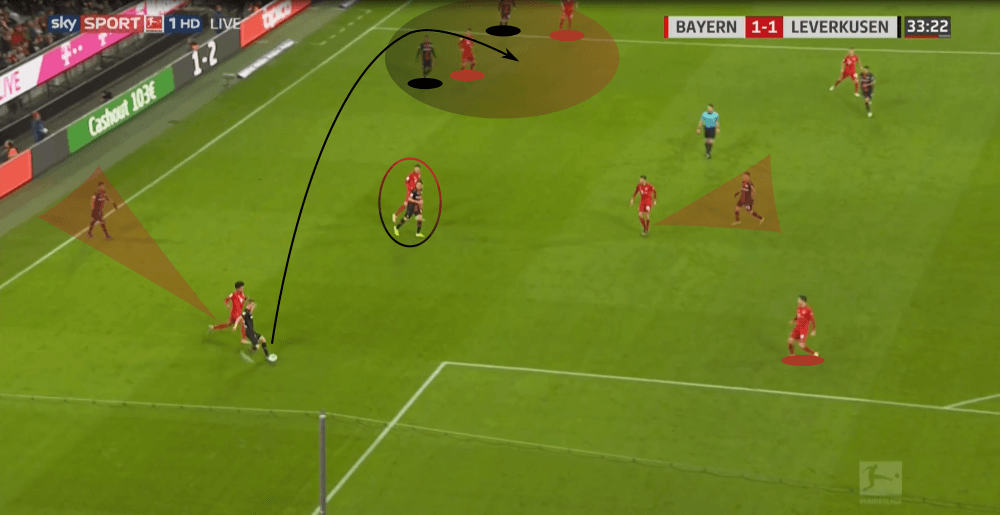
Second half: No goals but chances on both sides
Leverkusen continued their plan in the second half. They took Kimmich out of the game which forced Bayern to let Martínez and Alaba organise the build-up. However, Flick’s team were still able to create goalscoring opportunities, mainly after two situations: either when they came into one of the half-spaces from where they then were able to get behind the last line of Leverkusen’s defence, or when their counter-press worked off. As a result, they continued to use similar patterns as they had done in the first half.
In the first example below, we can see the already described idea as Flick’s squad is able to find Müller in the right half-space. He laid the ball off for Lewandowski who then played the ball to the right-wing where Pavard rushed forward. Bayern continued in the second half to create chances with the aid of crosses as in this situation.
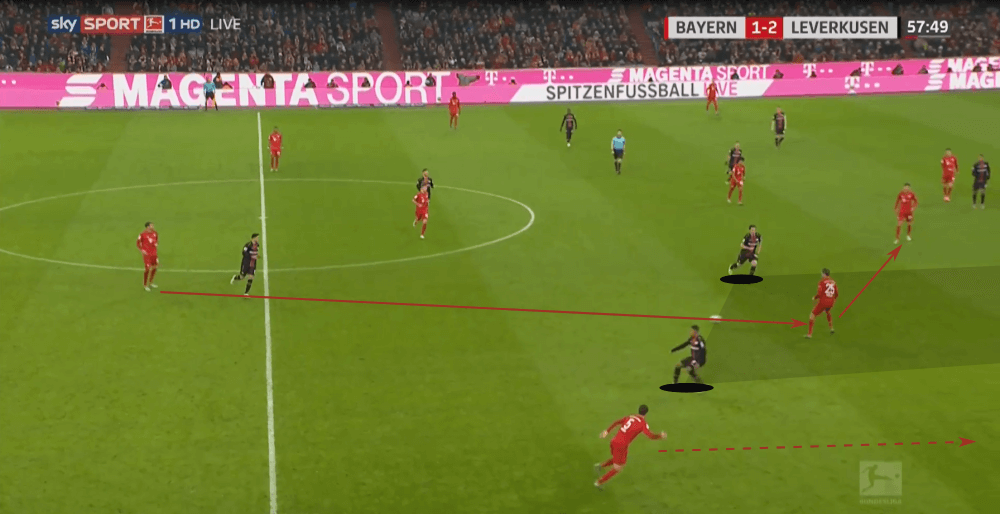
However, Flick’s team also forced their opponents to errors with the aid of their counter-pressing. In the shot below we can see Wendell passing the ball to Bailey. The Brazilian left-back partnered up with Baumgartlinger (#15) to win back the ball from Müller. Since Pavard knows that he shouldn’t allow Bailey to have time to control the ball or even turn around, he immediately starts the counter-press and puts pressure on Bailey who loses the ball to the Frenchman. Bayern immediately played into the danger zone in front of the goal, but once more can’t score a goal. The statistic that Flick’s team made after the 90 minutes 46 recoveries in the opposition’s half just shows how intense their high (counter-)pressing was.
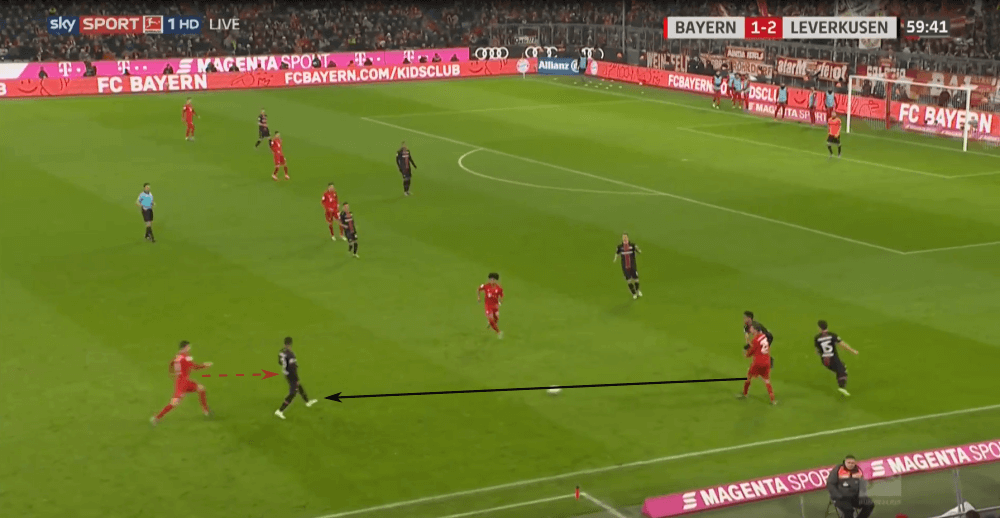
Meanwhile, Leverkusen stuck to their plan. The main difference to the first half was clearly that they sat back deeper and focused more on their defensive work. However, that didn’t mean that they would stop to use their pattern during the counterattacks which led to both goals in the first half. They always looked to find Volland up front who then had the task to play the ball to Diaby or Bailey. Since the Jamaican got injured in the situation against Pavard in the image above, they subbed on Karim Bellarabi for him who is also incredibly fast. In the image below, we can see once more how Volland receives a pass high up the pitch and then he turns to play the ball to Diaby who is then in a one-on-one situation against Davies.
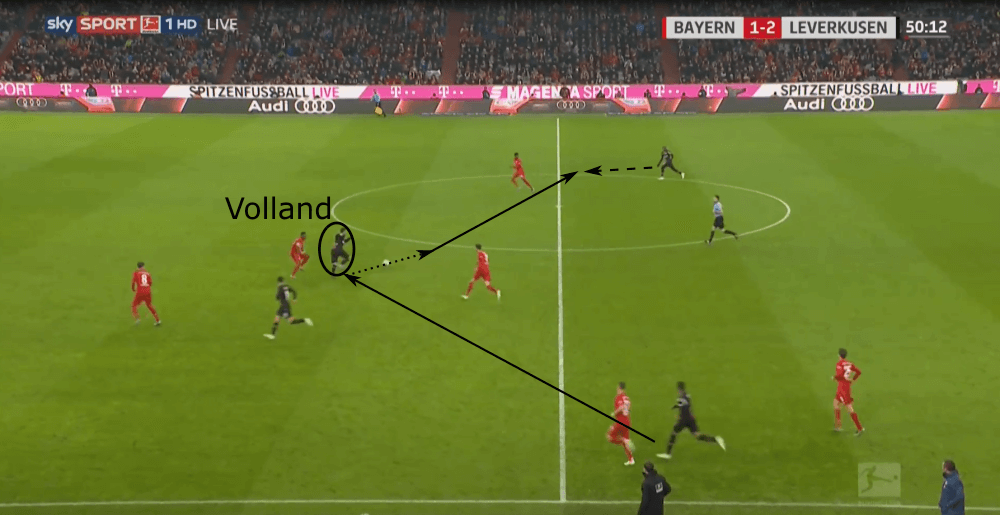
However, as Bellarabi later came on instead of Bailey, the Frenchman Diaby switched the side and played on the left-wing. Since he is faster than Pavard, they tried to utilise his speed and find him with through passes as they did before with Bailey. This resulted, for example, in the shot below in a one-on-one situation against Neuer, in which the German keeper successfully avoided a goal.
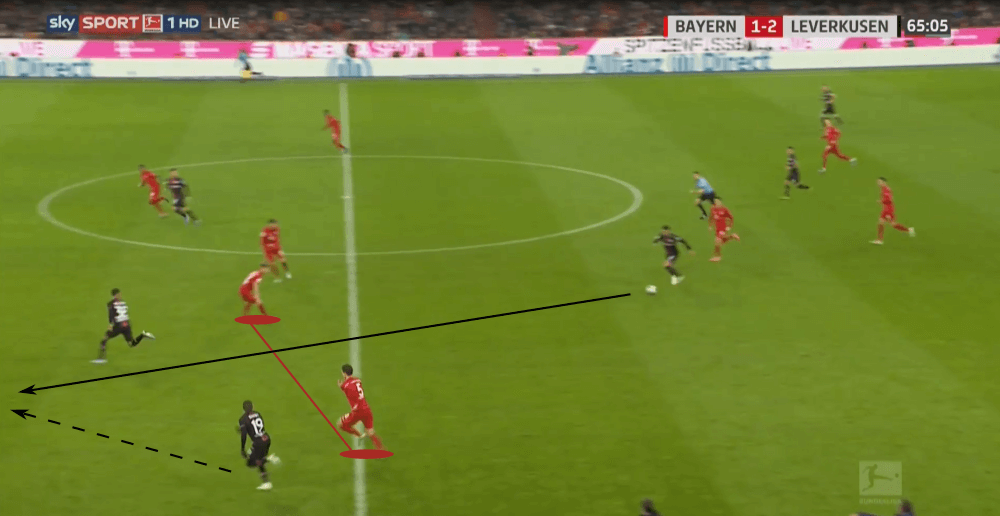
Final minutes
In the 81st minute, Tah saw the red card after a foul against Philippe Coutinho at the edge of the penalty box. The referee decided that he was the last man who could stop the Brazilian Magician and due to that he sent off the German centre-back. Whether it was really a red card is arguable, but the way how Coutinho came into this situation is quite interesting.
Especially in this period of the game, the Bavarians wanted to get into the space between the two banks of four with vertical passes. That worked off exactly ahead of the foul by Tah as we can see in the images below. Goretzka once more could be found by Alaba with a penetrating pass which the German lays off with his first touch for Coutinho. Tah needs to stop him since otherwise the Brazilian would have a good chance.
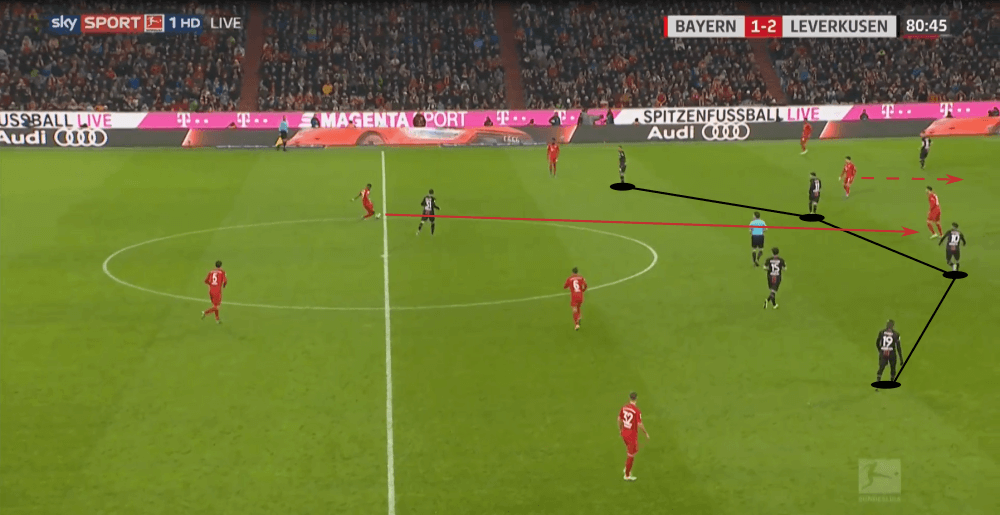
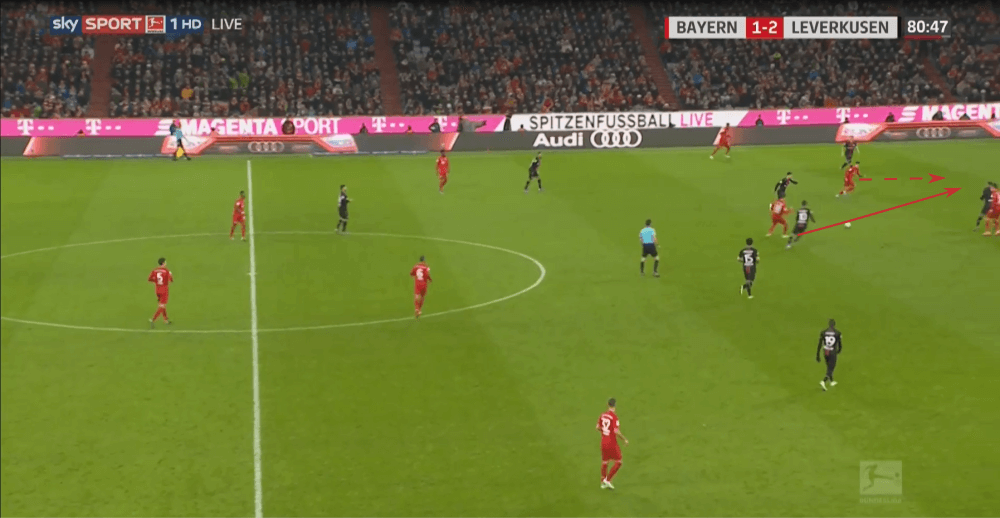
However, just a few moments ahead of this foul, Leverkusen had made the third change and because of that, they weren’t able to bring on a new substitute to react to the red card. Considering this, the 10 men who were left on the pitch had to adapt to the situation. Bosz decided to go for a 5-3-1, the 20-year-old Diaby and Bellarabi were the wing-backs while Daley Sinkgraven joined the two Benders in the central defence. Volland was the only striker while Amiri supported Baumgartlinger and Kerem Demirbay in the midfield.
The message which this formation sent out was clear: avoid attacks through the centre and force them into the wide areas. Leverkusen did well in this aspect. During the closing minutes of the game, Bayern constantly tried to create goalscoring chances with the aid of crosses. At the end of the game the Bavarians delivered 28 crosses, but just seven of them were successful. On the right side, Kimmich (who played then as a right-back since Thiago Alcántara came on) and Ganbry created two-on-one situations against Diaby while on the other side Davies and Kingsley Coman did the same against Bellarabi. Bellarabi and Diaby are, in truth, out-and-out wingers but they threw everything in they had to defend these crosses and in the centre, the Bavarians weren’t able to convert any of these crosses into a goal. Lewandowski once more hit the crossbar, but in the end, it was Leverkusen who successfully defended their lead until the final whistle of the referee.
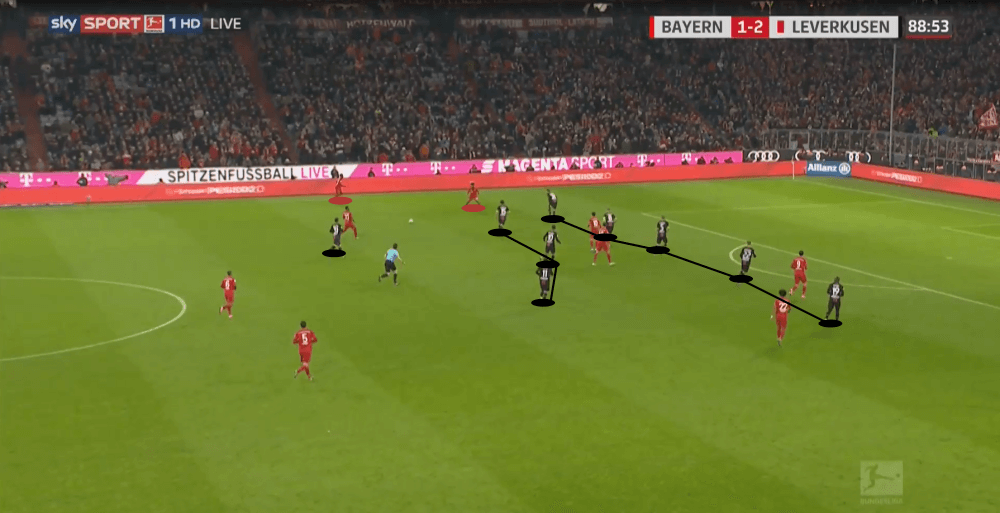
Conclusion
This was the first time in the history of the Bundesliga that Bayern lost a game in which Müller scored. However, you have to give credit to Leverkusen who played well and fought till the end. It’s also worth adding that they were lucky that Bayern made just one goal out of their numerous chances. After the match, many Leverkusen players as well as the coach noted that you would need that luck to get away with the three points in the Allianz Arena against Bayern.
After this match, the Werkself are just two points behind the Bavarians. Leverkusen’s next game will be against Schalke 04 at home while Bayern will face Borussia Monchengladbach away from home.

If you love tactical analysis, then you’ll love the digital magazines from totalfootballanalysis.com – a guaranteed 100+ pages of pure tactical analysis covering topics from the Premier League, Serie A, La Liga, Bundesliga and many, many more. Buy your copy of the November issue for just ₤4.99 here





Comments